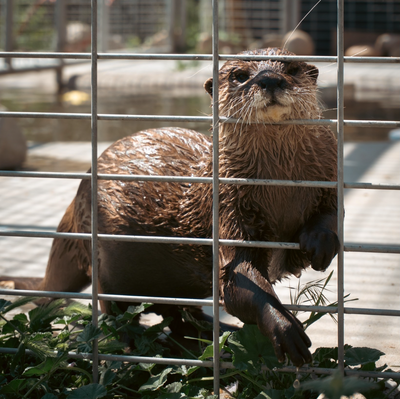The Small Asian Clawed Otter: Nature's Tiny Aquatic Genius
Babby Farms on 6th Jul 2025
In the freshwater streams and mangrove swamps of Southeast Asia lives one of nature's most remarkable creatures: the small Asian clawed otter. Also called the Oriental small-clawed otter, this adorable mammal is about the size of a house cat but has abilities that would make any engineer jealous. What makes these otters so special isn't just their undeniable cuteness, but their incredible special features that set them apart from every other otter species on Earth.
The Amazing Finger Power
The most extraordinary thing about small Asian clawed otters is their incredible hand skills. While other otters rely mainly on their mouths to catch prey, these remarkable animals have evolved something truly unique: partially webbed paws with flexible, finger-like parts that work almost like tiny hands.
Their front paws have small, blunt claws instead of the fully developed claws of other otter species. This change allows them to handle objects with amazing precision. Watch one of these otters hunt, and you'll see it using its sensitive fingertips to check every crack and gap underwater, feeling around for hidden prey like an underwater detective.
This touch-based hunting method has evolved for a very specific purpose. While other otters chase fish in open water, small-clawed otters are experts at pulling crabs, crayfish, mollusks, and small fish from tight spaces in shallow water. They can even crack open tough shells and handle complex objects with their nimble fingers. It's like having built-in tools that never get lost!
Built for Two Worlds
Small Asian clawed otters are perfectly designed for life both in water and on land. Their smooth bodies make them excellent swimmers, but they're also compact and sturdy enough for long land adventures. Weighing only 4 to 11 pounds, they can easily climb trees, scramble over rocks, and move through dense plants.
Their beautiful chocolate-brown fur works like a natural wetsuit. It has two layers: a soft, warming undercoat that keeps them warm, and longer guard hairs that trap air bubbles. These trapped air bubbles provide both warmth and help them float in water, working like tiny life preservers.
Unlike fully water-living sea mammals, these otters haven't given up their connection to land. They're equally comfortable swimming through water and exploring land environments. This flexibility allows them to find food and shelter in multiple places, making them incredibly good at surviving.
The Chatty Otter Family
Small Asian clawed otters are highly social animals with complex family structures. They live in groups of up to 12 individuals, typically including a mated pair and their offspring from several generations. These aren't just random groups either; they're well-organized family units with clear social levels and cooperative behaviors.
Their communication system is remarkably advanced. Scientists have identified at least 12 different sounds, each serving specific purposes. The soft chirping sounds that make them internet famous are actually contact calls that help family members stay in touch while looking for food. When they're content and relaxed, these gentle sounds create a constant soundtrack of family conversation.
More dramatic are their alarm calls: sharp, penetrating barks that alert the entire group to possible threats. These warning calls can travel far distances and are often answered by neighboring otter families, creating a neighborhood watch system that spans multiple territories.
Scent Messages and Territory Tales
Small Asian clawed otters also communicate through scent marking, using special glands to create unique chemical signatures. They place these scents at specific locations throughout their territory, creating what researchers call "scent newspapers" that share detailed information about the individual's identity, health, and recent activities.
Each otter family maintains a territory of about half a mile to a mile and a quarter along waterways. These territories are carefully selected to include diverse small habitats: shallow areas for hunting, deeper pools for swimming, rocky areas for climbing, and dense plants for shelter. The territory system isn't just about space; it's a smart resource management strategy that prevents overuse of prey species.
Learning Through Play and Teaching
The social structure of otter families creates fascinating opportunities for learning. Young otters don't simply inherit hunting instincts; they undergo a long education period where they learn complex techniques from their parents and older siblings.
Adult otters actively show hunting methods to their young, demonstrating how to extract prey from different types of hiding places. This kind of active teaching was once thought to be unique to humans and a few other highly intelligent species.
Play behavior serves crucial developmental functions beyond just entertainment. Young otters engage in elaborate games that develop coordination, problem-solving skills, and social bonds. Even adult otters continue playing throughout their lives, maintaining family relationships and practicing skills that may be critical during challenging times.
Ecosystem Engineers
Small Asian clawed otters play an important role in maintaining the health of their water ecosystems. By controlling populations of crustaceans, mollusks, and small fish, they help maintain the natural balance of their freshwater habitats. Their presence often indicates a healthy, functioning ecosystem with good water quality and abundant variety of life.
Scientists consider them an "indicator species" because their well-being reflects the overall health of their environment. When otter populations are thriving, it usually means the entire water ecosystem is in good condition. On the other hand, declining otter populations often signal environmental problems.
Facing Modern Challenges
Unfortunately, these remarkable animals face serious threats from human activities. Habitat destruction is the biggest problem. Across Southeast Asia, wetlands are disappearing rapidly due to city development, farm expansion, and palm oil plantations. The specialized shallow-water habitats that otters depend on are particularly vulnerable to these changes.
Pollution also poses significant challenges. Chemical runoff from farms and cities can contaminate the water and reduce prey availability. Plastic pollution and other debris can trap otters or contaminate their food sources.
Climate change adds another layer of difficulty. Changing rainfall patterns can alter water levels in the shallow systems that otters prefer, while rising temperatures may affect the distribution and abundance of their prey species.
The Illegal Pet Trade Problem
Small Asian clawed otters have unfortunately become popular in the illegal pet trade, partly due to their appealing appearance and playful nature on social media. However, otters make terrible pets and suffer greatly in captivity. They need complex social interactions with other otters, specialized diets, and access to appropriate water environments.
The pet trade not only harms individual animals but also threatens wild populations. Capturing otters for the pet trade often involves destroying entire family groups, since young otters are typically targeted and their protective parents are killed in the process.
Conservation Success Stories
Despite the challenges, there are encouraging conservation efforts underway. Several countries have established protected areas specifically designed to preserve otter habitats. Community-based conservation programs have successfully engaged local people in protecting otters while providing alternative ways to make a living.
Captive breeding programs, while not a replacement for habitat protection, have helped maintain genetic diversity and provided animals for reintroduction efforts. Some of these programs have been remarkably successful, with breeding facilities in Japan and other countries contributing to conservation efforts throughout the region.
A Future for Otters
The story of the small Asian clawed otter reminds us that even the smallest creatures can have complex lives and important ecological roles. These remarkable animals, with their incredible special features and sophisticated social behaviors, represent millions of years of evolutionary innovation.
Protecting small Asian clawed otters means preserving not just a species, but entire water ecosystems that support countless other plants and animals. Their survival depends on our collective commitment to maintaining healthy freshwater environments throughout Southeast Asia.
As we marvel at their skillful fingers and listen to their gentle conversations, we're witnessing something truly special. These otters embody the creativity and resilience of life on Earth. By ensuring their future, we're protecting a piece of our planet's incredible biological heritage for generations to come.

